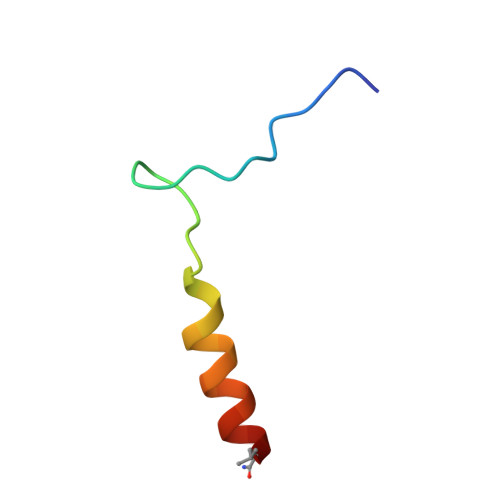Structure and influence on stability and activity of the N-terminal propeptide part of lung surfactant protein C
Li, J., Liepinsh, E., Almlen, A., Thyberg, J., Curstedt, T., Jornvall, H., Johansson, J.(2006) FEBS J 273: 926-935
- PubMed: 16478467
- DOI: https://doi.org/10.1111/j.1742-4658.2006.05124.x
- Primary Citation of Related Structures:
2ESY - PubMed Abstract:
Mature lung surfactant protein C (SP-C) corresponds to residues 24-58 of the 21 kDa proSP-C. A late processing intermediate, SP-Ci, corresponding to residues 12-58 of proSP-C, lacks the surface activity of SP-C, and the SP-Ci alpha-helical structure does not unfold in contrast to the metastable nature of the SP-C helix. The NMR structure of an analogue of SP-Ci, SP-Ci(1-31), with two palmitoylCys replaced by Phe and four Val replaced by Leu, in dodecylphosphocholine micelles and in ethanol shows that its alpha-helix vs. that of SP-C is extended N-terminally. The Arg-Phe part in SP-Ci that is cleaved to generate SP-C is localized in a turn structure, which is followed by a short segment in extended conformation. Circular dichroism spectroscopy of SP-Ci(1-31) in microsomal or surfactant lipids shows a mixture of helical and extended conformation at pH 6, and a shift to more unordered structure at pH 5. Replacement of the N-terminal hexapeptide segment SPPDYS (known to constitute a signal in intracellular targeting) of SP-Ci with AAAAAA results in a peptide that is mainly unstructured, independent of pH, in microsomal and surfactant lipids. Addition of a synthetic dodecapeptide, corresponding to the propeptide part of SP-Ci, to mature SP-C results in slower aggregation kinetics and altered amyloid fibril formation, and reduces the surface activity of phospholipid-bound SP-C. These data suggest that the propeptide part of SP-Ci prevents unfolding by locking the N-terminal part of the helix, and that acidic pH results in structural disordering of the region that is proteolytically cleaved to generate SP-C.
Organizational Affiliation:
Department of Medical Biochemistry and Biophysics, Karolinska Institutet, Stockholm, Sweden. jing.li@mbb.ki.se














